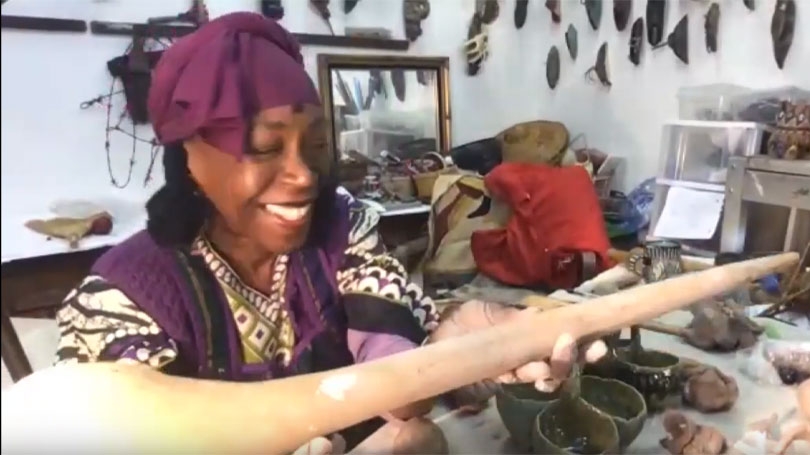Interview With Visiting Ceramic Artist Sana Musasama
This term the Ceramics Studio was lucky enough to host the artist Sana Musasama. She taught one of our Make it at Home classes, and spoke with students from her home studio in Queens, NY, which makes for one of the most interesting Zoom backgrounds I have yet to see. The walls are covered with dozens of vagina- esque pieces from a 20-year series she has done on female excision. Much of her art is inspired by her travels. Politics, tradition and custom are weaved together in work that represents the challenges and harms women face around the world. From watching her work during our Make it at Home class I saw how her process is a mix of both spontaneity and curiosity, as well as conscientiousness and intention. At first she showed us how she plays with clay, poking holes and weaving a rope of clay through them, or making tiny spirals and adding them to pieces. During the same class she also showed us some of her works in progress, including a series of topsy turvy dolls: two sided dolls that at first appear to be white, but if you flip the skirt over it becomes a black doll. These dolls were used by enslaved children so that they could play with a doll that looked like them, but quickly switch it back to a white doll if the master approached.
Sana first started working with clay in her last years at City College in NY. She had been studying anthropology, but she says that is was a deferred dream of her parents, and not her own dream. "It was something my mother and father would have loved to be had they not come up in the time of their history, when brown people were relegated to professions like nursing, schoolteacher, the military. It wasn't my passion; it was a family dream. I was always interested in the arts, but it wasn't something that was encouraged as a career in my generation."
Sana has had a fairly nontraditional path as an artist, and she emphasizes that her career came after she had already spent years pursuing this passion.
"I went after it as a passion, and then tried to make a career out of it. Big difference. What I did first was I educated myself about a material that I loved and then began to travel in the world of where it was. After years of working and studying you begin to exhibit because you want people to see your work, and after you exhibit you realize you need to apply for grants to keep doing it, and then you realize you need to do residencies. You are doing the beat without even realizing."
Teaching is another one of the ways that she has been able to have such a sustained career. "I was going after something that I felt very passionate about, and I went into teaching to support being an artist. I put the two together. I would love to have more creative time, and less teaching time. A friend of mine says that teaching is his form of activism, I never saw it that way, only as a way that would allow me to be an artist because it enabled me to pay my bills and buy supplies and travel."
Even if she doesn't consider her teaching to be activism, her art most certainly is. We talked about the purpose that art can serve in difficult and painful times, and how it can support work on issues of justice. "In different capacities art educates and enlightens people, it inspires people, but so does dance and so does writing. All the art forms rise up a community. I think having the desire to keep working during a time like this is particularly hard. I have been working for 40 years and during the pandemic I have worked less creatively than ever in my life because I got lost in a lack of community. As an artist I am feeling a responsibility to joining organizations that are not art, but that deal with the same undercurrents of my work on girl soldiers and sex trafficking, rituals in the lives of women that are damaging, that I should also align myself with people who are trying to educate these antiquated systems that have hurt women. Its contributing, whether as an artist or a person that I think is essential to staying connected especially during this pandemic."
Sana's art recommendations: El Anatsui
Sana's music recommendations: Nina Simone
